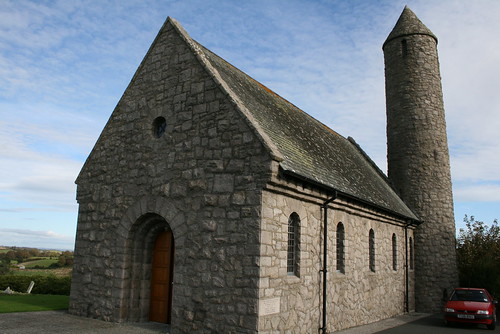
At the same time, the Roman Catholics were claiming Patrick as their own, dressing him up in medieval Catholic bishop-wear, erecting a statue of Patrick on another hill at Saul, and celebrating Patrick the Pope's envoy.
The Independence of the Celtic Church in Ireland does what it says on the tin. The author, WS Kerr, Rector of Seapatrick and Dean of Dromore, sets out to show that the Celtic Church of Patrick and Columba was independent of the Pope's authority and dominion, and thus justifying the Church of Ireland's claim to be the authentic successor of the apostle to Ireland.
Through a series of examinations of the writings of Patrick and other early Christian writings in, from and about Ireland and the Irish Church, Kerr demonstrates that the claims of the Catholic Archbishops of Armagh and Dublin in the early 1930s were entirely unfounded. Noting that Patrick never mentions the Pope or his authority in his writings (The Confession and the Epistle to Coroticus): 'The only conclusion is that St Patrick neither obtained nor recognised as supreme the sanction of the Roman Pontiff for his work in Ireland.' This is particularly so given the fact that his work was opposed. Had Patrick obtained the Pope's command to go he would have relied on this in his defence, rather than the reasons he so adequately does provide.
Similarly, Kerr finds in the writings few traces of later Catholicism, but instead the pure faith: 'Like the "Breastplate" it [the Hymn of St Sechnall] makes evident the evangelical scriptural fervour and purity of the religion of the Celtic Christians.' This is also found later when the Irish monk Columbanus writes to the pope, and declares that: 'For we Irish inhabiting the ends of the world are all disciples of St Peter and St Paul, and of all the disciples who by the Holy Spirit wrote the Divine Canon. We receive nothing beyond the evangelical and apostolic doctrine.' As Kerr notes, it is 'a fine description of the scriptural principles of the Irish Church.'
Kerr also finds that any of the later works on Patrick and the Irish fathers which claim that the Irish Church was Roman are actually falsifications by later copyists for their purposes of propaganda. At times, it was a heavy read to get through the information he presents, but his conclusions are easy to follow and accept.
All in all, Kerr demonstrates that the Irish Celtic Church was independent of Rome for several centuries, existing with its own authorities and traditions, this coming to an end only when the Synod of Whitby led to the inclusion (and suppression) of the Irish Church's traditions on the dating of Easter and the monk's tonsure. His conclusion therefore presents the distinct possibility of being Christian without coming under the authority of the Bishop of Rome as Pope. The vitality and position of the Church of Ireland is defended admirably, in those hot and heavy days.
While the ecclesiastical landscape may have changed in these past eighty years, we would do well to continue to learn from our past, those who established the true faith in this land of darkness, who had passed on the light of the gospel to us, and who expect it us to pass it on to the next generation.
The Independence of the Celtic Church in Ireland would be a good book for students of Irish History, and in particular Irish Church History, and should be found in most good second hand bookshops - John Gowan has plenty of copies for sure!

No respectable historian these days takes Kerr's stuff seriously. Of course St Patrick saw himself as a member of the western Christian church, and accepted the pope as Bishop of Rome. And, within the C of I, only the lunatic fringe would see the Celtic church as 'Protestant'. See the comments of the Ab of Armagh, Richard Clarke in Religion in Ireland: past present and future (1999) p 29, where he describes Kerr's vision of Patrick as 'a gross distorition of reality (to put it mildly)'.
ReplyDelete